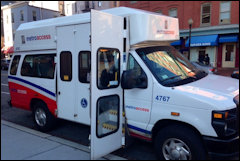 <i>This piece was originally published in the Chesterfield Observer.</i>
<i>This piece was originally published in the Chesterfield Observer.</i>
Only a few years ago, taxicabs were a non-factor in the Richmond region’s transportation equation. Few Richmonders used a taxi other than to ride to and from the airport. Then came the Uber revolution. While Richmonders still rely upon their own cars for routine needs, they often hail Uber for rides to restaurants where they’ll be drinking or to events where parking will be a hassle. Literally hundreds of Uber drivers are providing transportation services in the Richmond region today.
Ride-hailing services are still a tiny niche in Richmond’s transportation marketplace, but they have the potential to grow exponentially. In 2015 Uber introduced to Richmond its UberX shared-ridership service, which provides rides for up to four people. The inevitable logic of the Uber revolution is to build market share by spreading the cost of a trip over larger numbers of riders in order to reduce the price per rider. It’s only a matter of time, whether San Francisco-based Uber provides the service or a competitor does, before we see vans and buses using Uber-like technology to establish mass transit-like services – but with greater flexibility in routes and schedules.
The cost of transportation will get even cheaper when self-driving cars hit the roads. Eliminate the cost of compensating drivers, and prices will plummet. Meanwhile, deep-pocketed enterprises are experimenting in other cities with transportation-as-a-service: providing customers with a wide array of options – taxi-like ride hails, trips in vans or buses, car rentals by the hour and even bicycles – seamlessly knit together by the app on your smart phone.
Ten to 15 years from now, the transportation landscape in the Richmond region will be unrecognizable. People will have more options than ever. Local governments face a big question: What role should they play, if any?
Chesterfield has a big advantage over Richmond and Henrico County in adapting to the Uber revolution. The county never made a major commitment to the GRTC bus system. With its Pulse service, Richmond is doubling down on Bus Rapid Transit. Henrico is increasing its bus subsidies to expand its GRTC service. Politically, both will find it extremely hard to cut service in response to new opportunities. Chesterfield doesn’t have that problem. It is free to build a transportation system that takes full advantage of 21st-century technology.
The county took a small step in that direction last month when the Community Service Board partnered with Uber and Goodwill of Central and Coastal Virginia. The pilot program provides point-to-point transportation service for low-income Chesterfield residents accessing job training, employment opportunities, health care and even grocery stores. Passengers ride for free. The county reimburses Goodwill for each ride on a per-mile basis; Goodwill and Uber split a $5-per-ride administrative fee. By contrast, Access Chesterfield customers pay $6 for one-way rides and the county pays $33.15 per ride. If the partnership is successful, the county can either save a chunk of change or expand the program within the same budget.
Ride sharing and transportation as-a-service also can be powerful tools to reduce the number of vehicles on the road and reduce transportation congestion. Why can’t Chesterfield and the Virginia Department of Transportation dedicate a small fraction of the millions of public dollars spent each year on building new roads, highways and bridges to promoting shared ridership? Consider what Virginia Beach is planning for its beach resort redevelopment – creating a shared ridership drop-off zone. Could Chesterfield carve out small public spaces near hospitals, apartment buildings, employment centers and other major trip generators where Uber and its competitors can easily and conveniently pick up passengers and drop them off? Perhaps the clustering of riders at these drop-off zones could improve the economics of shared-ridership services, making them less expensive and thereby broadening the market. Try a series of inexpensive experiments to see what works and what doesn’t.
Uber is using Washington, D.C., as a test bed for its integrated shared ridership services, which includes bicycles and car rentals from individual owners. Lessons learned there could be applied to other metropolitan areas. Of course, the population density of Washington is more than 10 times greater than Chesterfield, so what works in Washington may not work here. But why can’t Chesterfield be a test bed for the vast low-density suburban market?
Uber is not welcomed by many local governments. The thanks the company gets in Washington is a proposal by Mayor Muriel E. Bowser to increase the gross receipt tax on ride-hailing companies from 1 percent to 4.75 percent to help fund the decrepit Washington Metro bus and commuter rail system. Imagine the reaction in Uber’s San Francisco headquarters if Chesterfield said, “Hey, Uber, we love you. We won’t tax you. We want to collaborate. Let’s build a 21st-century transportation system together.” It’s worth a shot.


